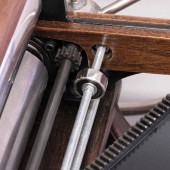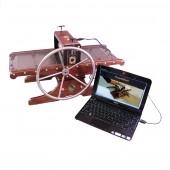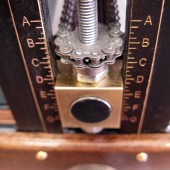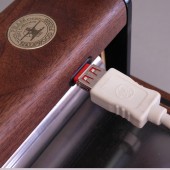
| THE AWARD |
| CATEGORIES |
| REGISTRATION |
| SUBMIT YOUR WORK |
| ENTRY INSTRUCTIONS |
| TERMS & CONDITIONS |
| PUBLICATIONS |
| DATES & FEES |
| METHODOLOGY |
| CONTACT |
| WINNERS |
| PRESS ROOM |
| GET INVOLVED |
| DESIGN PRIZE |
| DESIGN STORE |
| THE AWARD | JURY | CATEGORIES | REGISTRATION | PRESS | WINNERS | PUBLICATIONS | ENTRY INSTRUCTIONS |
Halfwood Printing Press by Bill Ritchie |
Home > Winners > Design #28078 >Interview |
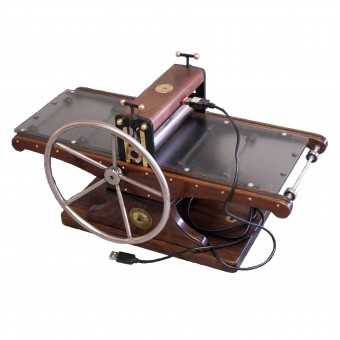 |
|
FS: What is the main principle, idea and inspiration behind your design?
BR: Hand-worked wood instruments and hand tools, such as musical instruments, craft and artists' tools, plus the grace and fittings of sailing ships, yacht interiors and even navigation devices inspire me. Since I am a fine art print maker, the presses made of wood in the 17th Century (Rembrandt's) and French 19th Century lithograph presses (Lautrec) also inspired me to design a press that was a beautiful artist's instrument. Since I was inspired by great print makers who were also teachers (S. W. Hayter) and I am a professor of printmaking I love to share what I learned over 50 years in the field. However, I am without a venue so I decided to embed my teaching in the press, using a flash memory drive the user can connect to a computer display.
FS: What has been your main focus in designing this work? Especially what did you want to achieve?
BR: I wanted to design a hand printing press which is beautiful in the same way a violin, oboe or piano is beautiful. Musicians perform their art on beautiful instruments, so why not visual artists? I also wanted it to function well, as a hand printing press must. It was my engineer and steel Wright associate, Tom, who was able to make a miniature which, despite its small size, is capable of professional prints. This provided me with great mobility—I can go anywhere, anytime, and print. It is especially important for me because I can use the press to teach and demonstrate the art. When I realized I can include videos, books, etc. in digital form on a flash memory drive, it was the “PressGhost”, the jewel in the crown and helps me reach my lifetime goal of being a good teacher.
FS: What are your future plans for this award winning design?
BR: We plan a worldwide network of Halfwood Press Workshops, cottage industry opportunities for people who love prints, printmaking, and print makers. In the USA, my future plan is a teaching company whose core product is the Halfwood press line and also software design for a printmaking teaching method. The software will include serious games based on printmaking and historic figures, such as Rembrandt who elucidate the artistic and cultural value of the fine art print and prints of historic importance.
FS: How long did it take you to design this particular concept?
BR: The first design was a simple pencil sketch which took seconds to draw. Adapting the sketch to available press designs took one week. Once a wood prototype was done and tested, reducing it to ¼ scale and building a second prototype took two weeks. In all, about one month. The addition of the PressGhost feature—which is an embedded flash memory drive with subject matter expertise for the user, took one week to design and test, excluding the assets.
FS: Why did you design this particular concept? Was this design commissioned or did you decide to pursuit an inspiration?
BR: Inspiration made me design it, preceded with my need for an etching press to take the place of one I sold. That was eight years ago, and when I took it to an art fair, I discovered there was a market, so I wanted to make them to sell, too. Over the years, we added to the line and 125 people worldwide bought them. They are handmade, “works of art,” and the last phase is the education feature, the PressGhost, which I designed to pursue my teaching goal and share the printmaking experience worldwide.
FS: Is your design being produced or used by another company, or do you plan to sell or lease the production rights or do you intent to produce your work yourself?
BR: I license the design and provide consulting services, thus far to one Warren Ralls, in England. He is our “test case” to establish best practices plus we want to prove the business feasibility of a worldwide network of Halfwood Press Workshops. My role will be to encourage and share with other people who love prints, printmaking and print makers and who want to develop the cultural and social value of fine art printmaking.
FS: What made you design this particular type of work?
BR: I saw a problem in the education of young people who want to learn printmaking, and although many artists, crafts people and designers have gone far to teach the methods of relief printing, such as stamping and stencil printing, the more complicated methods, such as intaglio and lithographic printmaking, are stymied because of the press—its size, costs, and sustainability issues. I solved the problem of size and sustainability by miniaturizing, and I reinforced the aesthetic of traditional printmaking by using good design features.
FS: Where there any other designs and/or designers that helped the influence the design of your work?
BR: Yes, a Canadian provided the basic mechanical engineering plans in 2004 on which I based the first Halfwood press, a large model. Then Tom, of the Kughler Company, elaborated on my design and solved manufacturing design. Ron Myhre contributed to the content development, that is, the marketing theme. Warren Ralls proved the feasibility of the Workshop approach, including the mobility aspect of the small press.
FS: Who is the target customer for his design?
BR: Women over fifty who are interested in the art, craft and design of prints and the processes of printmaking and, in addition, the social, cultural and community values made possible by owning a printing press.
FS: What sets this design apart from other similar or resembling concepts?
BR: Printing presses for fine art hand printmaking made for industrial-strength machines mainly for the college market. Economy, durability, and performance were key in printmaking classrooms and commercial publishing houses. The Halfwood printing press is a balance of esthetic design and engineering, a blend of old-world styling, fine, hand-finished varietal woods, colorful metal appointments and, of course, functionality.
FS: How did you come up with the name for this design? What does it mean?
BR: “Halfwood” refers to the printing press’ components, about half wood and half steel. We say, “Half wood, half steel, all real.”
FS: Which design tools did you use when you were working on this project?
BR: Off-the-shelf software is ACD See “Canvas” and Adobe “Creative Suite”. The workshop equipment and tools include a range of steel, brass, copper and, on the wood side, various saws and finishing tools—both power and hand tools.
FS: What is the most unique aspect of your design?
BR: Owners say, at first glance, say, “It is a work of art in itself,” and this asset is possibly the most unique aspect for a printing press. On closer inspection, finding the PressGhost (a flash memory drive embedded in the wood of the press) the reaction is, “You are giving us your mind!” Both assets—the aesthetics and the conceptual “ghost in the machine”—are unique.
FS: Who did you collaborate with for this design? Did you work with people with technical / specialized skills?
BR: Over a hundred people bought the Halfwoods between 2004-2012, and they provided feedback so I consider them to be collaborators. In the workshops, Tom Kughler was the engineer and the manufacturing engineer of the steel parts, plus he processed wood. Nick Dellos, a furniture designer, helped me with wood selection and taught me characteristics, plus showed me machinery I did not know about. Ron Myhre and Warren Ralls completed their own presses, showing me the way to make the printmaking press experience available to others.
FS: What is the role of technology in this particular design?
BR: By “technology” we mean using computer-aided-design in the visualization and mechanical processes of producing the presses. This would not be sufficient without the technology of feedback from satisfied users (and suggestions for design changes or added features). Technology also aide us in scaling the newer models, insofar as the designs were digital and therefore scalable with relative ease. Finally, the PressGhost is a technological invention on par with the “teaching machine” concept, i.e., when a digital device can help the new user through videos and illustrations.
FS: Is your design influenced by data or analytical research in any way? What kind of research did you conduct for making this design?
BR: After making and selling thirty Halfwood Printing Presses, the idea of marketing it to a larger number of people occurred. This was not a technological or design question, but the estimate of the market size was arrived at analyzing the population of print makers likely to want one. It was 2008, and the estimate was done by data mining to find art school populations spanning half a century, extracting those with printmaking experience and, finally, comparing this with the existing owners, whose profiles were in the Halfwood database. For making the design, no analytics were used on the aesthetic side; on the mechanical side, standard engineering principles were used, including “crash-testing.”
FS: What are some of the challenges you faced during the design/realization of your concept?
BR: Funding was a constant concern, as it was a highly speculative venture; it meant offering a printing press half the size of the competing press on the market at twice the price to purchase. As mentioned, thirty people had expressed their preference and sent their money for our press. Nevertheless, making the presses one at a time proved unprofitable in the short run. It was a necessary sacrifice in order to lay out other strategic plans involving print makers around the world. There were minor setbacks, mostly owing to improper shipping and handling, but all problems encountered were solved amiably because the printmaking world is populated with artistic and sensitive people, grateful for the design we have provided.
FS: How did you decide to submit your design to an international design competition?
BR: We searched for two years for a suitable design or woodworking contest, eager to reach a wider audience and locate businesses and manufacturers in the USA and abroad. It is our mission to establish small workshops worldwide and encourage the educational benefits of printmaking—a branch of art unique for its wealth of transferable skills. The search paid off as the search engines on the Web found we were interested in this kind of competition; despite we had only one week to apply, we made it!
FS: What did you learn or how did you improve yourself during the designing of this work?
BR: Speaking for myself, as the designer of both the aesthetic and conceptual (PressGhost) assets, I learned about manufacturing for a larger market, and the balancing act one must learn to keep quality and quantity correctly proportioned. Also I learned my limitations—as people were waiting as long as a year to get their press as I slowly finished the presses one at a time, tested and revised my designs, and promoted the press online with videos my wife and I produced by ourselves. Indeed, I probably improved my understanding of the benefits of developing networks to achieve our goals in the art and education field through the printmaking experience.
FS: Any other things you would like to cover that have not been covered in these questions?
BR: Through my experience I applied an old axiom I took for myself when I was a college professor teaching design: Design is a verb. As a verb, design is active and, if one is actively designing, one is always moving. Mistakes result, as Einstein said, when you are actively doing things. Invention is a rare thing and is often central to the active designer. Finally, systems depend on feedback, and the Halfwood is a result of feedback—from the first reactions at an art fair on a Pacific Northwest island to the thousands of dollars received by press owners—a good kind of feedback!
FS: Thank you for providing us with this opportunity to interview you.
A' Design Award and Competitions grants rights to press members and bloggers to use parts of this interview. This interview is provided as it is; DesignPRWire and A' Design Award and Competitions cannot be held responsible for the answers given by participating designers.
| SOCIAL |
| + Add to Likes / Favorites | Send to My Email | Comment | View Press-Release |
